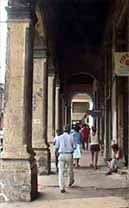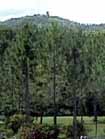|
Other Places |
|||||||||||||||||
|
|
|||||||||||||||||
|
Other Sections |
|||||||||||||||||
|
|
|||||||||||||||||
|
The city of Pinar del Río (Pop. 120,000) is the capitol of the province of the same name. The name, meaning "pine of the river," refers to the tall pines that grace river banks around the province, and especially flourish near in the extreme western side of the island.. The city of Pinar del Río is in fairly well upkeep by Cuban standards, especially considering the nationwide shortages of paint and construction materials. Like Havana, Pinar del Río features many beautiful pieces of beautiful architecture. Pinar del Río has a particular abundance of highly decorated, well maintained neoclassical buildings. Historically, the city of Pinar del Río the and surrounding area have been important in tobacco production. In the 18th century, smugglers seeking to evade the Spanish' monopoly on the tobacco trade chose this area because of its distance from the government in Havana, as well as the prime soil and conditions. As sugar cane became Cuba's primary cash crop, and single greatest source of economic income, however, the importance of Pinar del Río's tobacco crop fell and the city suffered from administrative neglect. Today, Pinar del Río manufactures some of Cuba's finest cigars, using tobacco leaves grown near the city. Pinar del Río is still considered an unimportant city by many Cubans, despite its size and economic significance relative to the rest of the towns in the province. Pinar del Río is home to many topnotch education and health care facilities, including the University of Pinar del Río, various vocational schools, and a well-respected nurses' academy.
|
|||

 Pinar del Río is not a top tourist destination in its own right, but as the area's largest city, plenty of tourists pass through for a day or two. Among the unique attractions offered in this city are cigar factory tours and gift shops, la Casa de la Culture (the House of Culture), and the beautifully restored Milanes Theater.
Pinar del Río is not a top tourist destination in its own right, but as the area's largest city, plenty of tourists pass through for a day or two. Among the unique attractions offered in this city are cigar factory tours and gift shops, la Casa de la Culture (the House of Culture), and the beautifully restored Milanes Theater.